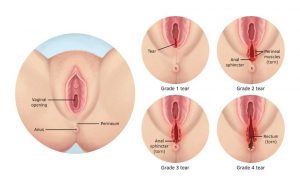If you’ve given birth before, you’d probably be familiar with the term perineal tear, which is a possible consequence of having a vaginal birth. Many women have experienced this, but is it as inevitable as it seems to be? Well, maybe not, so moms-to-be, take note, especially if you want to try your best to avoid a tear while giving birth.
Firstly, it would be good to know what is happening down there as you’re giving birth. During the second stage of labour, your baby’s head will start to enter into the vagina and move toward your perineum area. The perineal skin will then begin to thin out and stretch over your baby’s head. As your baby’s head starts to emerge out (this is known as crowning), the labia and vaginal opening also start to stretch around your baby’s head. A tear can happen if the skin and perineum do not stretch properly. Most women, if not all, don’t feel a tear happening. This could be due to being too preoccupied with the intensity and pressure felt during this last stage of labour.
There seem to be certain factors that increase the likelihood of perineal tearing are they are:
- Having a large baby
- Baby being born in a posterior position
- Increased weight gain during pregnancy
- A first vaginal birth
- Being of Asian ethnicity

Types of perineal tears
Four types of perineal tears or lacerations could occur while giving birth. The most common are first and second-degree tears.
A first-degree tear means a laceration has occurred but it is so small that it requires few or no stitches, where else a second-degree tear involves injury to the skin and muscle underneath and usually needs a few stitches.
Third-degree lacerations are a tear in the vaginal skin, perineal skin, and the muscle that extends to the anal sphincter (muscle around your anus). A fourth-degree tear is the same as a third-degree one except it extends into the anal sphincter and the tissue around it. Third and fourth-degree tears can affect your pelvic floor function and anal muscles.
While it’s not quite possible to tell if you will experience a tear or the severity of it for that matter, you can still take measures to minimise the risks of having a tear down there.
Take some preparation steps
Let’s face it — you don’t give birth everyday, and if you’re a first-time mom, parts of your body are going to perform something quite ‘heavy’ that they have never done before. Hence, some preparation makes sense, doesn’t it?
Unless you’re a naturally active individual, it’s highly likely that you don’t move around as much as you should. Exercise is important not just to keep you fit as a pregnant mom, but it also helps to improve circulation, which in turn improves skin elasticity. Also, improving blood flow to the perineum and vagina through orgasms can improve tissue health, if you get our drift!
Next, feed your body right, for good nutrition and hydration supports your skin and muscle health, including your perineal skin that has to stretch well to avoid tears. Include plenty of good fats, especially omega-3s (from fish, chia seeds, walnuts, and pumpkin seeds) and grass-fed or free-range meats for lean protein. A wide range of vegetables completes a healthy diet and will include nutrients such as Vitamin E, Vitamin C, and zinc. These will provide your perineal skin with the ability to stretch during labour and snapback faster too.
Pelvic floor exercises
Kegel exercises are unfortunately not very much practiced among Asian moms unless they happen to be enrolled in a birthing class of some sort. This is a shame, for these exercises are known to help strengthen the muscles in the pelvic floor and also help them snap back into shape faster after birth.
Learning to perform pelvic floor exercises correctly can help you to identify those muscles and use them to your full advantage. Our advice here is to enroll yourself into a birthing class, for you’ll learn a whole lot more than just how to perform kegel exercises properly.
Birthing position
The best position for birthing your baby with a lowered risk of tearing would be the one you choose instinctively for yourself and you feel most comfortable in. Unfortunately, the lithotomy position, which is lying down with legs held up, or even a semi-reclining position, has long been known to place pressure onto the tailbone and perineum. These positions also reduce the size of the pelvic floor and increase the likelihood of a tear.
It’s also been found over and over again that women who are free to move about during labour are more likely to find the position that helps them cope with contractions at each particular stage. Some women like to float free of gravity in water, others like to have their feet firmly planted on the ground.
The least stressful positions for the perineum, include:
- On hands and knees
- Leaning forward in a supported standing, kneeling, or sitting position
- Lying on the side
Note that while squatting and kneeling are useful upright positions, if the woman’s knees are very wide apart the perineum will still be stretched sideways and this may increase the likelihood of tearing.
Warm compresses
During the crowning stage, a warm flannel or compress held to the perineum may help reduce severe tearing. The warmth increases the blood flow to the area and if counter pressure is used it can even be of some relief. However, not all women can tolerate this method, for some may not be able to tolerate any kind of contact at the perineal area during the birthing process.

Perineal massages
Preparing the perineum via perineal massages during pregnancy has been shown to reduce the risk of tearing in mothers having their first vaginal birth. Self-administered perineal massage can help a woman to become familiar with her own body and have confidence in its ability to stretch and birth her baby. However, not all women are comfortable with the idea of perineal massages, although most who have tried them reported positive outcomes.
Choose your hospital or birthing center well
What we mean by this is, discuss your plans of avoiding tears (including episiotomy incisions) with your hospital or birthing center — this way you can find out what their policy is on avoiding tears or episiotomies for that matter. Pick a hospital or birth center that will support you and aid in your labour to prevent tears as much as they can.


